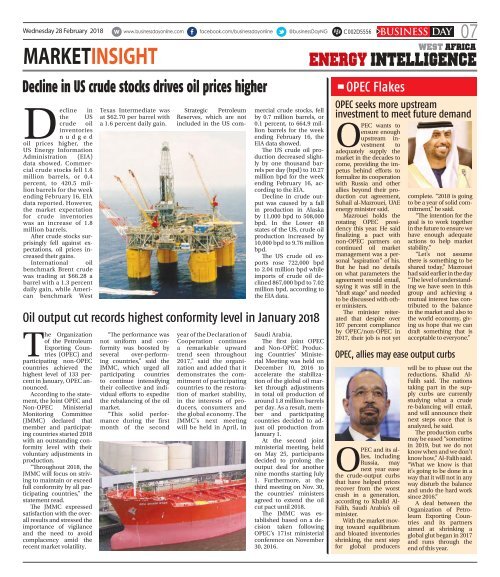BusinessDay 28 Feb 2018
Create successful ePaper yourself
Turn your PDF publications into a flip-book with our unique Google optimized e-Paper software.
Wednesday <strong>28</strong> <strong>Feb</strong>ruary <strong>2018</strong><br />
marketinsight<br />
Decline in US crude stocks drives oil prices higher<br />
Decline in<br />
the US<br />
crude oil<br />
inventories<br />
n u d g e d<br />
oil prices higher, the<br />
US Energy Information<br />
Administration (EIA)<br />
data showed. Commercial<br />
crude stocks fell 1.6<br />
million barrels, or 0.4<br />
percent, to 420.5 million<br />
barrels for the week<br />
ending <strong>Feb</strong>ruary 16, EIA<br />
data reported. However,<br />
the market expectation<br />
for crude inventories<br />
was an increase of 1.8<br />
million barrels.<br />
After crude stocks surprisingly<br />
fell against expectations,<br />
oil prices increased<br />
their gains.<br />
International oil<br />
benchmark Brent crude<br />
was trading at $66.<strong>28</strong> a<br />
barrel with a 1.3 percent<br />
daily gain, while American<br />
benchmark West<br />
The Organization<br />
of the Petroleum<br />
Exporting Countries<br />
(OPEC) and<br />
participating non-OPEC<br />
countries achieved the<br />
highest level of 133 percent<br />
in January, OPEC announced.<br />
According to the statement,<br />
the Joint OPEC and<br />
Non-OPEC Ministerial<br />
Monitoring Committee<br />
(JMMC) declared that<br />
member and participating<br />
countries started <strong>2018</strong><br />
with an outstanding conformity<br />
level with their<br />
voluntary adjustments in<br />
production.<br />
“Throughout <strong>2018</strong>, the<br />
JMMC will focus on striving<br />
to maintain or exceed<br />
full conformity by all participating<br />
countries,” the<br />
statement read.<br />
The JMMC expressed<br />
satisfaction with the overall<br />
results and stressed the<br />
importance of vigilance<br />
and the need to avoid<br />
complacency amid the<br />
recent market volatility.<br />
Texas Intermediate was<br />
at $62.70 per barrel with<br />
a 1.6 percent daily gain.<br />
“The performance was<br />
not uniform and conformity<br />
was boosted by<br />
several over-performing<br />
countries,” said the<br />
JMMC, which urged all<br />
participating countries<br />
to continue intensifying<br />
their collective and individual<br />
efforts to expedite<br />
the rebalancing of the oil<br />
market.<br />
“This solid performance<br />
during the first<br />
month of the second<br />
Strategic Petroleum<br />
Reserves, which are not<br />
included in the US com-<br />
mercial crude stocks, fell<br />
by 0.7 million barrels, or<br />
0.1 percent, to 664.9 million<br />
barrels for the week<br />
ending <strong>Feb</strong>ruary 16, the<br />
EIA data showed.<br />
The US crude oil production<br />
decreased slightly<br />
by one thousand barrels<br />
per day (bpd) to 10.27<br />
million bpd for the week<br />
ending <strong>Feb</strong>ruary 16, according<br />
to the EIA.<br />
Decline in crude output<br />
was caused by a fall<br />
in production in Alaska<br />
by 11,000 bpd to 508,000<br />
bpd. In the Lower 48<br />
states of the US, crude oil<br />
production increased by<br />
10,000 bpd to 9.76 million<br />
bpd.<br />
The US crude oil exports<br />
rose 722,000 bpd<br />
to 2.04 million bpd while<br />
imports of crude oil declined<br />
867,000 bpd to 7.02<br />
million bpd, according to<br />
the EIA data.<br />
Oil output cut records highest conformity level in January <strong>2018</strong><br />
year of the Declaration of<br />
Cooperation continues<br />
a remarkable upward<br />
trend seen throughout<br />
2017,” said the organization<br />
and added that it<br />
demonstrates the commitment<br />
of participating<br />
countries to the restoration<br />
of market stability,<br />
in the interests of producers,<br />
consumers and<br />
the global economy. The<br />
JMMC’s next meeting<br />
will be held in April, in<br />
Saudi Arabia.<br />
The first joint OPEC<br />
and Non-OPEC Producing<br />
Countries’ Ministerial<br />
Meeting was held on<br />
December 10, 2016 to<br />
accelerate the stabilization<br />
of the global oil market<br />
through adjustments<br />
in total oil production of<br />
around 1.8 million barrels<br />
per day. As a result, member<br />
and participating<br />
countries decided to adjust<br />
oil production from<br />
January 1.<br />
At the second joint<br />
ministerial meeting, held<br />
on May 25, participants<br />
decided to prolong the<br />
output deal for another<br />
nine months starting July<br />
1. Furthermore, at the<br />
third meeting on Nov. 30,<br />
the countries’ ministers<br />
agreed to extend the oil<br />
cut pact until <strong>2018</strong>.<br />
The JMMC was established<br />
based on a decision<br />
taken following<br />
OPEC’s 171st ministerial<br />
conference on November<br />
30, 2016.<br />
C002D5556<br />
OPEC Flakes<br />
OPEC wants to<br />
ensure enough<br />
upstream investment<br />
to<br />
adequately supply the<br />
market in the decades to<br />
come, providing the impetus<br />
behind efforts to<br />
formalize its cooperation<br />
with Russia and other<br />
allies beyond their production<br />
cut agreement,<br />
Suhail al-Mazrouei, UAE<br />
energy minister said.<br />
Mazrouei holds the<br />
rotating OPEC presidency<br />
this year. He said<br />
finalizing a pact with<br />
non-OPEC partners on<br />
continued oil market<br />
management was a personal<br />
“aspiration” of his.<br />
But he had no details<br />
on what parameters the<br />
agreement would entail,<br />
saying it was still in the<br />
“draft stage” and needed<br />
to be discussed with other<br />
ministers.<br />
The minister reiterated<br />
that despite over<br />
107 percent compliance<br />
by OPEC/non-OPEC in<br />
2017, their job is not yet<br />
OPEC and its allies,<br />
including<br />
Russia, may<br />
next year ease<br />
the crude-output curbs<br />
that have helped prices<br />
recover from the worst<br />
crash in a generation,<br />
according to Khalid Al-<br />
Falih, Saudi Arabia’s oil<br />
minister.<br />
With the market moving<br />
toward equilibrium<br />
and bloated inventories<br />
shrinking, the next step<br />
for global producers<br />
BUSINESS DAY<br />
07<br />
WEST AFRICA<br />
ENERGY intelligence<br />
OPEC seeks more upstream<br />
investment to meet future demand<br />
complete. “<strong>2018</strong> is going<br />
to be a year of solid commitment,”<br />
he said.<br />
“The intention for the<br />
goal is to work together<br />
in the future to ensure we<br />
have enough adequate<br />
actions to help market<br />
stability.”<br />
“Let’s not assume<br />
there is something to be<br />
shared today,” Mazrouei<br />
had said earlier in the day<br />
“The level of understanding<br />
we have seen in this<br />
group and achieving a<br />
mutual interest has contributed<br />
to the balance<br />
in the market and also to<br />
the world economy, giving<br />
us hope that we can<br />
draft something that is<br />
acceptable to everyone.”<br />
OPEC, allies may ease output curbs<br />
will be to phase out the<br />
reductions, Khalid Al-<br />
Falih said. The nations<br />
taking part in the supply<br />
curbs are currently<br />
studying what a crude<br />
re-balancing will entail,<br />
and will announce their<br />
next steps once that is<br />
analyzed, he said.<br />
The production curbs<br />
may be eased “sometime<br />
in 2019, but we do not<br />
know when and we don’t<br />
know how,” Al-Falih said.<br />
“What we know is that<br />
it’s going to be done in a<br />
way that it will not in any<br />
way disturb the balance<br />
and undo the hard work<br />
since 2016.”<br />
A deal between the<br />
Organization of Petroleum<br />
Exporting Countries<br />
and its partners<br />
aimed at shrinking a<br />
global glut began in 2017<br />
and runs through the<br />
end of this year.


















